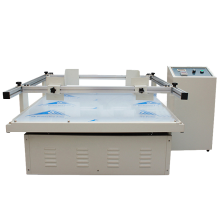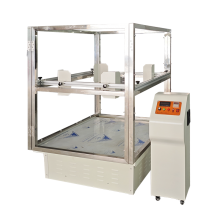Three-Axis Vibration Testing Machine - XYZ Multi-Directional Simulation
| Item | DR-B216 |
| Max. Test Load | 100kg |
| Frequency Range | 60-300rpm |
| Amplitude Range | 25.4mm (1 inch) |
| Simulation Speed | 25~40km/h |
| Vibration Mode | Roundtrip |
| Work Table Size | 1000*1200 mm ( L*W, can be customized ) |
| Outside dimension ( L*W*H ) | 1255*1070*660mm |
| Speed Mode | DC converter or AC Frequency Control |
| Power Capacity | 1 HP |
| Weight | 150kg |
| Power | 220V, 50 Hz |
| Speed Mode | DC converter or AC Frequency Control |
| Environmental Conditions | Temperature: 5~40°C; Related Humidity<85% |
Purchasing a Simulated Transportation Shaker involves a series of planned steps to ensure that the equipment purchased meets your testing needs and budget. Below is a detailed buying process:
1. Define your needs
Type of product to be tested: Identify the type of product that needs to be tested, e.g. electronics, automotive parts, furniture, etc.
Test Standards: Understand and identify the test standards and specifications that need to be met, such as ISO, ASTM, ISTA, etc.
Test conditions: define the frequency range, amplitude range, load capacity and other specific parameters required for testing.
2. Market research
Supplier selection: research and select several reputable suppliers, such as Shandong Derrick Analytical Instruments Co.
Comparison of products: Compare the product models, performance parameters, prices, after-sales service, etc. of different suppliers.
3. Technical communication
Communicate with suppliers: Communicate in detail with the technical support team of the supplier to confirm whether the equipment meets your testing needs.
Request for technical information: Ask the supplier to provide technical manuals, performance parameters, test cases and other information of the equipment.
4. Request for quotation
Request for Quotation: Send a detailed request for quotation to the selected supplier, including testing requirements, technical parameters, etc.
Get quotation: Suppliers provide detailed quotation according to your requirements, including equipment price, transportation cost, installation and commissioning cost, etc.
5. Contract Signing
Contract terms: read the contract terms carefully and make sure that the contract specifies the equipment specifications, price, delivery time, after-sales service and so on.
Signing the contract: sign a formal purchase contract with the supplier.
6. Equipment Purchase and Transportation
Payment of deposit: Pay the deposit according to the contract.
Equipment production and transportation: the supplier starts to produce the equipment and arranges transportation within the agreed time.
7. Equipment Acceptance
Arrival Inspection: Upon arrival of the equipment, conduct an appearance inspection to ensure that the equipment is not damaged.
Functional test: In accordance with the contract and technical data, carry out functional test and performance verification of the equipment.
Signing of acceptance report: sign the acceptance report after passing the inspection.
8. Installation and commissioning and training
Installation and commissioning: the supplier's technical personnel to the site for the installation and commissioning of the equipment to ensure that the equipment operates normally.
Operation training: the supplier provides equipment operation training to ensure that the operator is familiar with the use and maintenance of the equipment.
9. After-sales service
After-sales service: understand the supplier's after-sales service content, including warranty period, maintenance response time.
Maintenance: formulate the maintenance plan of the equipment, and carry out regular maintenance of the equipment.
10. Case reference
Reference cases: Check the successful cases provided by the supplier, and understand the evaluation and experience of other users on the equipment.
By following these steps, you can systematically complete the purchase process of a simulated transportation shaker to ensure that the equipment you purchase will meet your testing needs and stay within your budget.

Send Inquiry to This Supplier
You May Also Like
-
ISTA 1A Vibration Testing Equipment - Single Package SimulationUS$ 900 - 2000MOQ: 1 Set
-
Tear Strength Tester for Textile/Film - ASTM D1424 & ISO 13937 CertifiedUS$ 2000 - 3000MOQ: 1 Set
-
Digital Tear Tester for Plastic Packaging - 0-100N Range ±0.1% AccuracyUS$ 2000 - 3000MOQ: 1 Set
-
Industrial Tear Tester for Corrugated Paperboard - 200mm/s Test SpeedUS$ 2000 - 3000MOQ: 1 Set
-
Bulk Discount! Tear Strength Testers for Global Packaging SuppliersUS$ 2000 - 3000MOQ: 1 Set
-
Textile Fabric Tear Strength Test Equipment Automatic Paper Strength Elmendorf Tearing TesterUS$ 2000 - 3000MOQ: 1 Set
-
Elmendorf Method Paper Tearing Strength TesterUS$ 2000 - 3000MOQ: 1 Set
-
Multi-Material Tear Tester (Plastic/Rubber/Paper)US$ 2000 - 3000MOQ: 1 Set
-
Fabric Tear Resistance Meter Electronic Textile Paper Elmendorf Tearing Strength TesterUS$ 2000 - 3000MOQ: 1 Set
-
Elmendorf Tearing Strength Tester ISO 1974 ASTM D1922 D1424 for Testing Fabric Tear ResistanceUS$ 2000 - 3000MOQ: 1 Set












